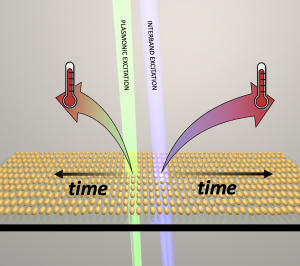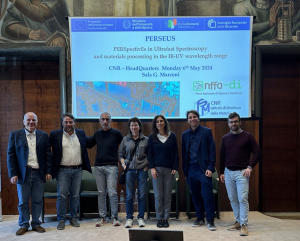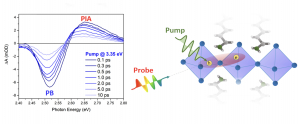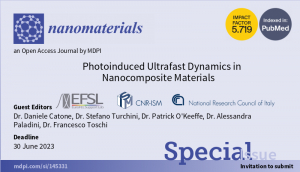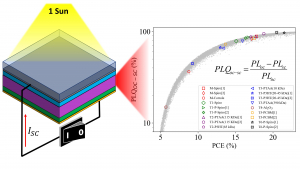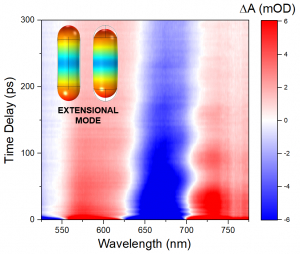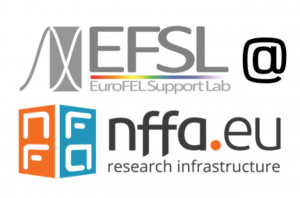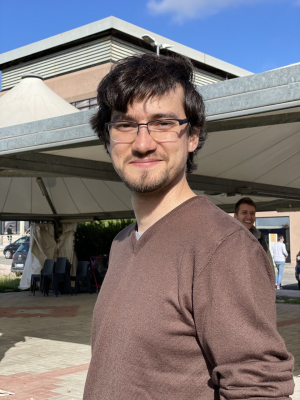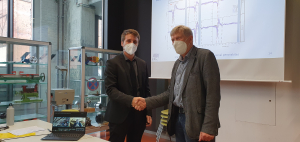Alessandra Paladini
Efsl at the European Researchers' Night 2024
The European Researchers' Night promoted by the European Commission is back: the EFSL team will meet children and adults to immerse them in the world of science and technology with Illumina(mi).
Ultrafast Dynamics of Nonthermal Carriers Following Photoexcitation of palsmonic nanostructure
An article on the different dynamics of nonthermal carrier generation in two-dimensional arrays of gold nanoparticles, following their photoexcitation at the plasmon resonance or the interband transition, has been published in ACS Photonics: "Ultrafast Dynamics of Nonthermal Carriers Following Plasmonic and Interband Photoexcitation of 2D Arrays of Gold Nanoparticles."
The publication is the result of a collaboration between the EFSL research group at CNR-ISM and researchers from CNR-SPIN, CNR-IFN, the Università di Genova, and the Politecnico di Milano.
Workshop PERSEUS - PERSpectivEs in Ultrafast Spectroscopy and materials processing in the IR-UV wavelength range
On Monday 6th of May, in the beautiful setting of the Marconi room of the CNR, the Workshop PERSEUS - PERSpectivEs in Ultrafast Spectroscopy and materials processing in the IR-UV wavelength range took place, organized by EFSL as part of the activities of the NFFA-DI project.
Band Structure and Exciton Dynamics in Quasi-2D Dodecylammonium Halide Perovskites
Published on Advanced optical Material the paper Band Structure and Exciton Dynamics in Quasi-2D Dodecylammonium Halide Perovskites. It is the outcome of the collaboration between researchers from EFSL, CNR-IMM, CNR-NANOTEC, Università di Roma Tor Vergata, Università degli Studi di Perugia and Università del Salento: Giuseppe Ammirati, Faustino Martelli, Patrick O'Keeffe, Stefano Turchini, Alessandra Paladini, Maurizia Palummo, Giacomo Giorgi, Marco Cinquino, Milena De Giorgi, Luisa De Mhttps://nanotec.cnr.en/arco, Daniele Catone.
Special Issue “Photoinduced Ultrafast Dynamics in Nanocomposite Materials” of Nanomaterials
The new Special Issue entitled "Photoinduced Ultrafast Dynamics in Nanocomposite Materials" published by the journal Nanomaterials (ISSN 2079-4991, IF 5.719) is currently open for manuscript submissions with a deadline set at the 30th June 2023. This Special Issue is promoted by the research staff of the EuroFEL Support Laboratory (EFSL) of Istituto di Struttura della Materia of National Research Council of Italy who will act as Guest Editors.
The Special Issue is intended to collect articles on the ultrafast photophysical and dynamical properties of different types of nanocomposite and nanostructured materials and their applications, including: semiconductors with various morphologies such as nanowires, 2D materials, carbon-based materials, multilayer systems, thin films, photonic crystals, metallic and non-metallic plasmonic materials, highly doped semiconductors, transparent conductive oxides, hybrid perovskite materials, organic polymeric materials, organic blends, topological insulators and self-assembled systems. Studies of the photoinduced ultrafast dynamics in hybrid systems which combine two or more of the above materials are particularly welcome, without excluding nanostructured materials in general.
The aim of this Special Issue is to provide a showcase for articles that show the interplay between photoinduced ultrafast dynamics and relevant operating parameters of nanocomposite materials, indicating a route to optimize their photophysical properties and therefore the efficiency of the devices containing them.
The EFSL staff invite all of you to submit your manuscripts and contribute to the success of this Special Issue!
Photoluminescence and efficiency in perovskite solar cells
The paper "Re‐evaluation of Photoluminescence Intensity as an Indicator of Efficiency in Perovskite Solar Cells" has been published in the Solar RRL journal. It is the outcome of a collaboration between EFSL, CNR-IMM (Istituto per la Microelettronica e i Microsistemi) and CHOSE (Centre for Hybrid and Organic Solar Energy – Regione Lazio) researchers: Valerio Campanari, Faustino Martelli, Antonio Agresti, Sara Pescetelli, Narges Yaghoobi Nia, Francesco Di Giacomo, Daniele Catone, Patrick O'Keeffe, Stefano Turchini, Bowen Yang, Jiajia Suo, Anders Hagfeldt and Aldo Di Carlo.
The photoluminescence (PL) intensity is often used as an indicator of the performance of perovskite solar cells (PSCs) and indeed steady-state PL is therefore used for the characterization of these devices and their constituent materials. However, some features of perovskite materials and devices, if not taken adequately into account, could lead to misleading results. In this work we show that the value of the photoluminescence quenching occurring when the PSCs are switched from open- to short-circuit is an excellent figure of merit (FOM) for the evaluation of the PSC efficiency. In order to take into account the large inhomogeneity of the performance in the PSC yield and their temporal instability, we have used a systematic approach to comparison the PSC conversion efficiency and their PL intensity using a large group of PSCs with efficiency varying from 5.63% to 21.5%. The PSCs were fabricated using different materials both as regards the absorbing materials and the transport layers, different structures, and relatively different fabrication processes. We found that the use of the bare PL intensity in open-circuit (OC) is not a general and reliable indicator of the performances when a large heterogeneous ensemble of devices is used, Instead, considering the values of the PL intensity both at open OC and short circuit (SC) , it is possible to correlate the PL intensity to the device power conversion efficiency (PCE) through a figure of merit based on the quenching of the PL observed in SC and OC conditions (PLQoc-sc=(PLoc-PLsc)/PLoc). We explain the observed correlation between PLQoc-sc and the PCE of the device by means of a simplified model based on the carrier density rate equation, in which the extraction time of the photoexcited carriers in the PSC is duly considered. We have also shown that the analysis of PLQoc-sc using our model can provide a tool to estimate the carrier extraction time in PSCs through a simple cw-PL measurement, provided the carrier lifetime in OC conditions is known. Without suggesting that a PL measurement can substitute a J-V characterization, we point out that our study is an important contribution to the understanding the physical mechanisms underlying carrier recombination and extraction. Moreover, we have found a clear correlation between the increase over time of the PL intensity in SC conditions and the contemporary decrease of the short-circuit current, Isc, a feature that can be easily understood within the framework of our model and FOM.
Acoustic Vibration Modes of Gold–Silver Core–Shell Nanoparticles
The EFSL research group, in collaboration with the Laboratoire Lumière, Matière et Interfaces and the Laboratoire de Physique des Solides of Université Paris-Saclay (France) and with the Institut des Molécules et Matériaux du Mans of Le Mans Université, has published a paper in the Chemosensors journal. The title of the article is "Acoustic Vibration Modes of Gold–Silver Core–Shell Nanoparticles" by Tadele Orbula Otomalo, Lorenzo Di Mario, Cyrille Hamon, Doru Constantin, Francesco Toschi, Khanh-Van Do, Vincent Juvè, Pascal Ruello, Patrick O'Keeffe, Daniele Catone, Alessandra Paladini and Bruno Palpant.
https://doi.org/10.3390/chemosensors10050193
We are part of the NFFA European Network!
A good start to 2022 for the EFSL lab: we are officially part of the NFFA European network (https://www.nffa.eu/)!
It is now possible to request and get support for access to our laboratory through this new opportunity, too:
- Pump-Probe (https://www.nffa.eu/offer/
- PhotoLuminescence (https://www.nffa.eu/offer/
Welcome Valerio!
EFSL staff congratulates Valerio Campanari on having won a research grant under the Project "FOTONICS - Fabrication and Optimization of the broadband phoTodetectOr based oN topologICal insulator and Silicon", funded by Regione Lazio.
Graduation of Giuseppe Ammirati at Wildau
On 17th September 2021, Giuseppe Ammirati received his Master's degree in Fotonics at Technische Hochshule Wildau (Germany), with a thesis entitled “Ultrafast dynamics in quasi bidimentional perovskites”.
Our congratulations to Giuseppe for this further achievement.

